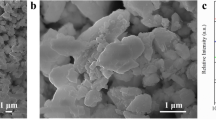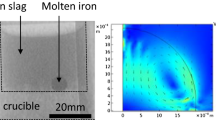Abstract
This paper discusses the results of several experiments designed to further illustrate the recent findings of the present authors according to which, if a virtually leak-fee maximum bubble pressure system is used to measure the surface tension of liquid aluminium, a surface tension around 1100 mJ m−2 is first obtained, decreasing to the oxidized value (around 865 mJ m−2) as the experiment proceeds and oxygen enters the system mainly through the capillary walls. The peculiarities and difficulties inherent to the maximum bubble pressure method are illustrated. For instance, a study of the time needed for the surface tension to decrease to the oxidized value as a function of temperature reveals the important role played by the vapour pressure in the process. This is further illustrated by considering Al-Mg alloys, as magnesium has a different heat of vaporization and a much larger vapour pressure than aluminium at the measuring temperatures. Results for the changes in density and surface tension for the oxidized and unoxidized cases induced by magnesium (up to 8 wt%) are also presented and compared to previous data.
Similar content being viewed by others
References
L. Goumiri and J. C. Joud, Acta Metall. 30 (1982) 1397 and references therein.
A. Pamies, C. Garcia-Cordovilla and E. Louis, Scripta Metall. 18 (1984) 869.
G. Lang, Aluminium 49 (1973) 231 and references therein.
D. G. White, Metall. Rev. 13 (1968) 73.
B. C. Allen, in “Liquid Metals” edited by S. Z. Beer (Marcel Dekker, New York, 1972) p. 161.
E. D. Hondros, in “Physicochemical Measurements in Metals Research”, Vol. IV, Part 2, edited by R. A. Rapp (Interscience, Wiley, New York, 1970) pp. 293–348.
G. Lang, J. Inst. Met. 101 (1973) 300.
Idem, Aluminium 50 (1974) 731.
M. Cantor, Ann. Physik 283 (1982) 399.
E. Shrödinger, ibid. 46 (1915) 413.
R. E. Honig and D. A. Kramer, in “Physicochemical Measurements in Metals Research”, Vol. IV, Part 1, edited by R. A. Rapp (Interscience Wiley, New York, 1970) pp. 505–531.
C. J. Smithells, (ed), in “Metals Reference Book” 5th Ed. (Butterworths, London, 1976) p. 231.
L. I. Maissel and R. Glang, (eds), in “Handbook of Thin Film Technology” (McGraw-Hill, New York, 1970) pp. 2–39.
E. Chacón, F. Flores and G. Navascues, J. Phys. F: Met. Phys. 14 (1984) 1587.
A. M. Korol'kov, Otdelenie, Teknicheskik Nauk 2 (1965) 35.
E. Pelzel, Berg.-u. Hütternmänn Monatsh. Leoben 93 247.
Idem ibid. 94 (1949) 10.
Author information
Authors and Affiliations
Rights and permissions
About this article
Cite this article
Garcia-Cordovilla, C., Louis, E. & Pamies, A. The surface tension of liquid pure aluminium and aluminium-magnesium alloy. J Mater Sci 21, 2787–2792 (1986). https://doi.org/10.1007/BF00551490
Received:
Accepted:
Issue Date:
DOI: https://doi.org/10.1007/BF00551490




